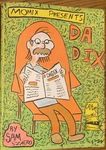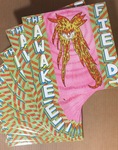
Created and compiled during the first wave of the pandemic and released just as the second wave was getting started, this issue can make for some grim reading at times, but it is also by turns moving, insightful, revealing, and even, yes, humorous. The covers and section-heading illustrations by Eleanor Davis are startlingly on target and make for a small masterpiece of illustration in and of themselves.
The Features for this issue are:
Comfort Food by Victoria Ying on finding comfort in your culture when you're under threat.
The Emergency We’ve Accepted by Amber Cortes and Carl Nelson on homelessness during the crisis.
In/Vulnerable by Thi Bui and the reporting team at Reveal on inequity in the pandemic.
An Unstoppable Force by Yazan al-Saadi and Omar Khouri on the pandemic exploding into Lebanon.
Love In the Time of Corona by Max Loh, an essential worker who found himself in a long distance relationship when the Singapore-Malaysian border shutdown with no end in sight.
With Dispatches, Strips, and other contributions from:
For The Response on major life events during the pandemic: Meghan Turbitt, Ryan Alexander-Tanner, Whit Taylor, and Elizabeth Haidle.
Pandemic stats by Andy Warner, Archive editorial cartoons of pandemics past, and The Nib interview with Black Trans Lives march organizer Fran Tirado by Tuck Woodstock and illustrated by Ethan X. Parker.
Dispatches from Laura Athayde, Molly Brooks, Niccolo Pizarro, Steve Teare, Arigon Starr with Kalle Benallie, Lisa Rosalie Eisenberg, Meg O’Shea, and Colleen AF Venable with Ellen T. Crenshaw.
Strips by Gemma Correll, Joey Alison Sayers, Pia Guerra, Charis JB, Matt Bors, Eleri Harris, Matt Lubchansky, Ben Passmore, Mike Dawson, Emily Flake, Kendra Wells, and Jorge Gonzalez.
With illustrations by Noah Van Sciver, Shan Horan, Xulin Wang, and Mark Kaufman.

Caitlin McGurk has done the comics world a great service in rescuing from obscurity the enormous and unjustly forgotten talent of Barbara Shermund. This hefty, oversize (9 1/4" x 12 1/4"), 288 page hardcover is filled to the brim with excellent quality reproductions – black & white and full color – of Shermund's cartoons and illustrations for The New Yorker, Esquire, Judge and many other publications, as well as advertisements for clients ranging from Pepsi-Cola to Lux detergent. It also includes some examples of her early student artworks.
This project has been long in the works, having its roots in a 2020 exhibition. The archive of Shermund's works deposited at the Billy Ireland Cartoon Library & Museum at The Ohio State University, where McGurk is, respectively, the Curator of Comics and Cartoon Art and Associate Professor, forms the core of artworks reproduced here, but McGurk traveled further afield, accessing collections and archives from New York to San Francisco and places in between, so as to provide a fully rounded overview of Shermund's creative output.
The book is filled out with McGurk's highly sympathetic and deeply researched biographical essay spanning Shermund's life and career. It traces her ancestry – on one side, back to colonial America – and includes her childhood and early adulthood in San Francisco where, among much else, she experienced the great earthquake, before focusing on detailing the period of her life during which she created the work for which she is known and which fills the pages of this volume. During these years – which began during the "jazz age" and continued on throught the depression, WW II and the post-war period – while living largely in New York City and upstate NY – interspersed with various peripatetic periods before moving to nearby coastal New Jersey – she shaped her career and formed her attachments. This life of Shermund is peppered with photographs throughout, documenting a variety of stages of her life. And while there is far more documentation of Shermund's career than her personal life, McGurk does her best to fill in the blanks and connect the dots to create a fully fleshed out portrait of the artist as a woman in a man's world.
Tell Me a Story Where the Bad Girl Wins makes an important contribution to the history of comics and will be a welcome and treasured addition to many a library and collection.
Fanta sez:
Tell Me a Story Where the Bad Girl Wins doubles as an official biography and coffee table art collection honoring the life and art of pioneering cartoonist Barbara Shermund, an unheralded early master of magazine cartooning whose career spanned the heyday of American magazines from the 1920s–1960s. Her sharp wit and loose style boldly tapped the zeitgeist of first-wave feminism with vivid characters that were alive and astute. Shermund’s women spoke their minds about sex, marriage, and society; smoked cigarettes and drank; and poked fun at everything in an era when it was not common to see young women doing so. Shermund left behind a body of work that was ahead of its time and remains insightful, witty, relevant, and contemporary.
As one of the first women cartoonists to work for The New Yorker the year of its launch in 1925, she created nine covers and more than 600 cartoons for the magazine, in addition to countless spot illustrations, giving the nascent publication its unique visual brand. Shermund later became a mainstay at Esquire; contributed to Life, Colliers, Judge, and more; had a syndicated newspaper cartoon published by King Features; and illustrated a variety of books. In 1950, Shermund was among the first three women to be accepted as a member of the male-dominated National Cartoonist Society. A compelling facet of Shermund’s work, particularly for The New Yorker, is her frequent nods to queer audiences. More than any other New Yorker cartoonist at the time, Shermund’s work seemed to do this the most. There are indications in her personal files that she also may have been queer, including love letters and other personal archives.
Readers will discover Shermund’s unique and vibrant life and art, and gain an understanding of how women’s place in the history of cartooning has been controlled and sublimated by greater societal and cultural allowances. Through close readings, archival research, reproductions of original art, correspondence and photographs, this volume uncovers and celebrates a trailblazing female magazine cartoonist, and rightfully places her in the canon of cartoon art history.
"This exhaustively researched and illustrated tribute outlines the liberated life of Barbara Shermund, a free spirit who mercilessly sketched the grandes dames and dumb blondes of the milieu she inhabited but to which she refused to conform. It allows the prolific Shermund to take her place alongside Helen Hokinson, Mary Petty, and the other magnificent star women artists who shaped the early days of the magazine one hundred years ago." — Françoise Mouly, art editor, The New Yorker
ONE FIRST PRINT copy left.

Here's the NYRC Hype-Up:
Rea Irvin was The New Yorker’s first art editor and creator of the magazine’s iconic mascot, the butterfly enthusiast Eustace Tilly. In 1930, he ventured into new territory with the comic strip The Smythes. The Smythes—comprised of John, Margie, and their two forgettable children, Willie and Maudie—are a niceish suburban family, restless in their social stature, and eager to climb a sometimes wobbly social ladder. Irvin’s distinct, graceful line renders the Smythes in all their glory and hilarity as they navigate ill-fated dinner parties with pompous socialites, fend off robbers dressed as Santa, and get chased out of restaurants by cleaver-wielding chefs.
The Smythes drolly captures the joys, heartbreaks, and humiliations of being in a family. Handpicked by acclaimed cartoonists R. Kikuo Johnson and Dash Shaw—who also penned the introduction together—this new selection of Smythes strips also includes an enlightening afterword by comics historian Caitlin McGurk. An unsung masterpiece of cartooning, The Smythes is finally available to a new generation of readers ready to marvel at the full reach of Irvin’s artistic abilities.
ISBN: 9781681379548

Bubbles #23 is 60 pages long
This issue will feature all the talks and interviews from Bubbles Con 2. Complete with photos and writing about the weekend.
Interviews:
- Charles Burns (a talk informed by Dan Nadel)
- Tara Booth (by Brian Baynes)
- Kevin Huizenga (by Thomas Campbell of Comics Blogger)
- John Vasquez Mejias (by Brian Baynes)
- Juliette Collet (by Rae Whitlock)
Talks:
- Ryan Holmberg Talk on Manga: Horror, Me, and My Basement
- Caitlin McGurk Talk: Tell Me a Story Where the Bad Girl Wins: The Life and Art of Barbara Shermund
Art from:
- Rae Whitlock
- Jennifer Kennedy
- Dan Zettwoch
Also: reviews of new comics; more!









